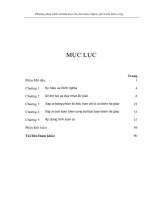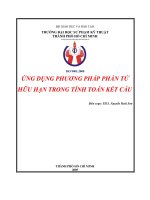Áp dụng phương pháp phần tử hữu hạn trong bài toán đồng nhất hóa vật liệu đàn hồi không đồng nhất
Bạn đang xem bản rút gọn của tài liệu. Xem và tải ngay bản đầy đủ của tài liệu tại đây (90.27 KB, 5 trang )
Áp dụng phương pháp phần tử hữu hạn trong
bài toán đồng nhất hóa vật liệu đàn hồi không
đồng nhất
Trần Nguyên Quyết
Trường Đại học Công nghệ
Luận văn ThS. Cơ học kỹ thuật; Mã số: 60 52 01 01
Người hướng dẫn: PGS.TSKH. Phạm Đức Chính, TS. Trần Anh Bình
Năm bảo vệ: 2014
Abstract. Luận văn đã xây dựng được các công thức xác định các hệ số đàn hồi của cốt
liệu hình tròn trong mô hình vật liệu tương đương với vật liệu đàn hổi đẳng hướng hai
chiều hai pha cốt liệu elip, từ giới hạn cốt liệu phân bố thưa. Nhờ đó quá trình tính toán
khi đồng nhất hóa vật liệu đàn hổi đẳng hướng hai pha cốt liệu elip được đơn giản hóa.
Đồng thời, luận văn đã áp dụng phương pháp phần tử hữu hạn làm cơ sở cho phương
pháp số, lập trình trên phần mềm Matlab để thực hiện đồng nhất hóa vật liệu đàn hồi
đẳng hướng hai pha không đồng nhất, đối với các mô hình vật liệu tuần hoàn theo hình
vuông và hình lục giác đều. Từ đó, chúng tôi đã ứng dụng kết quả đồng nhất hóa bằng
phương pháp số này để kiểm tra kết quả xác định hệ số đàn hồi của vật liệu thông qua
mô hình cốt liệu tròn tương đương với mô hình thực, và với đánh giá Hashin –Shtrikman.
Kết quả so sánh là tốt. Kết quả này có thể ứng dụng trong việc đồng nhất hóa các vật liệu
đẳng hướng cốt liệu elip trong thực tế. Đồng thời có thể sử dụng làm cơ sở để xây dựng
công thức xác định các mô hình tương đương cho các mô hình vật liệu khác.
Keywords. Cơ học kỹ thuật; Phương pháp phần tử hữu hạn; Vật liệu đàn hồi
Content.
Chương 1. Tổng quan.
Chương 2. Hệ số đàn hồi của cốt liệu tròn trong vật liệu đẳng hướng tương đương vật liệu cốt
liệu elip
Chương 3. Phƣơng pháp phần tử hữu hạn trong đồng nhất hóa vật liệu đàn hồi không đồng nhất.
Chương 4. Tính toán – so sánh bằng phương pháp số
- Kết Luận: nêu các kết quả luận văn đạt đƣợc, các ứng dụng và ý nghĩa của luận văn cũng như
đề xuất thêm hƣớng nghiên cứu mới trong thời gian tới.
References.
Tiếng Việt:
1. Trần Anh Bình (2014), Xấp xỉ phân cực cho các mô đun đàn hồi vật liệu 3D đa thành phần
đẳng hướng, Hội nghị Cơ học kỹ thuật toàn quốc Kỷ niệm 35 năm thành lập Viện Cơ học, Hà
Nội.
2. Phạm Đức Chính (1995), Đánh giá các tính chất cơ lý vĩ mô của vật liệu đẳng hướng nhiều
pha, Luận án Phó tiến sĩ khoa học toán lý, Hà Nội.
3. Phạm Đức Chính (1996), Đánh giá các tính chất cơ lý của vật liệu tổ hợp đẳng hướng và đa
tinh thể, Luận án Tiến sĩ khoa học toán lý, Hà Nội.
4. Ngô Hương Nhu (2001), Phương pháp phần tử hữu hạn trong cơ học vật rắn biến dạng, Viện
Cơ học, Hà Nội.
5. Chu Quốc Thắng (1997), Phương pháp phần tử hữu hạn, NXB Khoa học và Kỹ thuật, Hà Nội.
Tiếng Anh:
6. Beran, M.J, (2005), Statistical Continuum Theories, NewYork, Wiley.
7. Christensen, R.M,(1979), Mechanics of Composite Materials, Newyork, Wiley.
8. Pham Duc Chinh (2013), Essential Solid Machanics, Institute of Mechanics, VAST, Hanoi.
9. Eshelby, J.D. (1957): The determination of the elastic field of an ellipsoidal inclusion and
related problems. Proc. R. Soc. Lond. A 241, 376–396
10. Erwin Stein, René de Borst, Thomas J. R. Hughes (2004), Encyclopedia of computational
mechanics Volume 1,2,3, John Wiley & Sons.
11. Hashin Z. (1962), The elastic moduli of heterogeneous materials, J. Appl. Mech. 29,143-
150.
12. Hashin Z. (1965), On elastic behaviour of fiber reinfoeced materials of arbitrary transverse
phase geometry. J. Mech. Phys. Solids 13, 119.
13. Hashin Z., Strikman S(1963). A variational approach to the theory of elastic behaviour of
multiphase materials. J. Mech. Phys. Solids 11, 127-140.
14. Hashin Z., Rosen W., (1964), The elastic moduli of fiber reinforced materials,
J.Appl.Mech.31, 223.
15. Hill R(1952), The elastic behaviour of a crystalline aggregate, Proc. Phys. Soc. A65,349-
354.
16. Hill R. (1965), Self-consistent mechanics of composite materials. J. Mech. Phys. 13, 213-
222
17. G. R. LiuS. S. Quek (2003), The Finite Element Method: A Practical Course, Elsevier
Science.
18. Miller, M.N, (1969), Bounds for the effective elastic bulk modulus of heterogeneous
materials, J.Math. Phys.10, 2005 – 2013.
19. Milton G.W (2001), The theory of composite, Cambridge University Press.
20. Mori, T., Tannaka, K. ,(1973), Average stress in matrix and averege elastic energy of
materials with misfitting inclusions, Acta Metall.21 571 – 574.
21. Norris, A.N.,(1985), A differential scheme for effective moduli of composites, Mech.
Mater.4, 1-16.
22. Norris, A.N.,(1989), An examination of the Mori – Tanaka effective medium
approximation for multiphase composites, ASME J.Appl. Mech.56 83 – 88.
23. S. Nemat-Nasser, M. Hori, Micromechanics,(1993): Overall properties of heterogeneous
materials. North-Holland, Amsterdam.
24. Paul B, (1960), Prediction of elastic constans of multiphase materials, Trans.ASME 218,36.
25. Pham.D.C (2013), Strong-contrast expansion correlation approximations for the effective
elastic moduli of multiphase composites, Archive of Aplied Mechanic.82,377-389.
26. Pham.D.C (1997), Estimations for the overall properties of some isotropic locally-ordered
composites, Acta Mech. 121 177-190.
27. D.C. Pham , A.B. Tran, Q.H. Do (2013), On the effective medium approximations for the
properties of isotropic multicomponent matrix-based composites, International Journal of
Engineering Science 68 (2013) 75–85
28. Pham.D.C (2012), Bounds on the elastic moduli of statistically isotropic multicomponent
materials and random cell polycrystals, International Journal of Solids and Structures 49 2646 –
2659.
29. Pham.D.C (2000), Weighted self-consistent approximations for elastic completely random
mixtures, Mechanics of Materials 32 463- 470.
30. Pham D.C. (1996), On macroscopic conductivity and elastic properties of perfectly –
random cell composites, Int.J.Solids Struct.33, 1745 -1755.
31. Pham D.C,(1993), Bounds on the effective shear modulus of multiphase materials,
Int.J.Eng.Sci.31,11-13.
32. Pham D.C,(1994), Bounds the effective conductivity and elastic moduli of fully-disordered
multicomponent materials, Arch.Ration.Mech.Anal.127, 191 -198.
33. Pham D.C,(1994), Estimations for the overall properties of some isotropic locally – ordered
composites, Acta Mech.121, 177-199.
34. Phan – Thien, N., Pham, D.C, (1997), Differential multiphase models for polydispersed
suspensions and particulate solids, J. Non – Newtonion Fluid Mech.72, 305 – 318.
35. Phan Thien, N., Milton, G.W.,(1983), New third-oder bounds on the effective moduli of N-
phase composites, Q.Appl.Math.41, 59-74.
36. Reuss, A. (1929). Berechnung der Fliebgrenze von Mischkristallen auf Grund der
Plastizitatzsbedingung fur Einkristalle. ZAMM, 9, 49
37. Torquato,S.,(2002), Random Heterogenenous Materials, Springer.
38. Tran, A.B., Yvonnet, J., He, Q-C., Toulemonde, C., Sanahuja, J. (2011): A multiple level
set approach to prevent numerical artefacts in complex microstructures with nearby inclusions
within XFEM. Int. J. Numer. Meth.Eng., 85:14361459.
39. Voigt, W. (1928). Lehrbuch der Krystallphysik . Leipzig: Teubner
40. Yvonnet, J., He, Q-C., Toulemonde, C. , (2008): Numerical modelling of the effective
conductivities of composites with arbitrarily shaped inclusions and highly conducting interface.
Compos. Sci. Technol., 68:28252828.
41. O.C. Zienkiewicz; R.L. Taylor,(2000), The Finite Element Method, Butterworth –
Heinmann.
42. Weng, G.J, (1984), Some elastic properties of reinforce solids, with special reference to
isotropic ones containing spherical inclusion,Int.J Eng.Sci.22, 845.
43. Willis,J.R, (1981), Variational and related methods for the overall properties of composite
materials, In:Yih,C.S, (Ed), Advances an Appl.Mech.Academic Press, 2-78.
44. Wolpole L.J (1966), On bounds for the overall elastic moduli of inhomogeneous systems,
J.Mech.Phys.Solids.14 , 152-162.
Tiếng Pháp:
45. Anh Binh TRAN, (2008), Modélisation numérique du comportement viscoélastique du
béton par la méthode ”Level-Set” et la méthode des éléments finis étendus, Master de Recherche
(M2), Université Paris-Est Marne-La-Valée.









